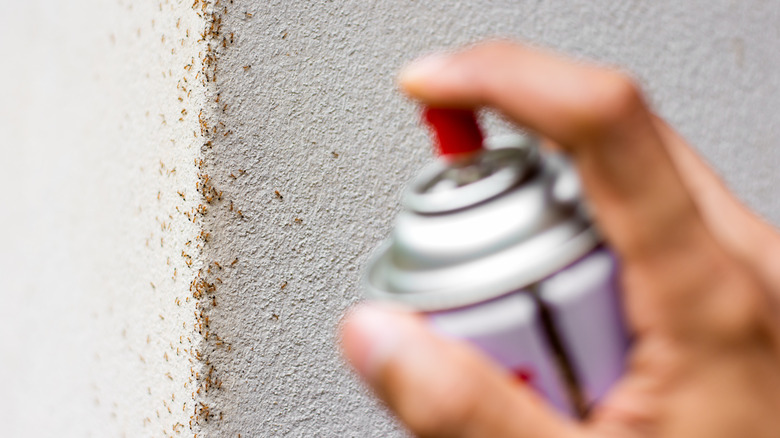What To Do If You Find Ants Lurking In Your Walls
Noticing a row of ants climbing along the length of your wall might be enough to make your flesh crawl. And if following their trail leads you to a visibly hollowed-out wooden wall with mounds of dust piled at the side, you know you aren't only dealing with severe property damage. Your home will likely reek of bad odor or ring with scratchy, chewing noises. Luckily, you don't have to put up with the nuisance forever and can get rid of ants through several methods. Just shower the foragers with an insecticidal spray to eliminate them immediately, or leave ant powder around their lurking spots that kick in only when the swarmers return to their den.
As ants have a penchant for the dark and damp (and food), they often snuggle deep into the gaps and fractures in walls, merrily multiplying and building their colonies. Reaching these hidden groupings is tedious, but you can ensnare them with ant bait and wait for colonial destruction. Just experiment with DIY baits like honey or fried food before setting a trap, as ants are fussy about food and love changing their preferences with the season.
Banishing ants from walls
Contact insecticide sprays are your go-to if you can't tolerate the ants scurrying along your walls. They're convenient, budget-friendly, and cover ground quickly while giving instantaneous results and clearing trails that help the pesky invaders navigate. You can even use them to create an effective barrier to prevent ants from climbing up. However, even sprays like Raid carry unsafe chemicals like cypermethrin and imiprothrin, making them unsuitable for use around kids and pets. Moreover, they may cause budding or segmentation in colonies, especially among carpenter ants, which are harder to deal with and difficult to target.
While a non-repellant ant spray can take care of these issues, it does stain and requires quite a bit of cleaning, which probably explains why some prefer using insecticide dust instead. These odor-free powders are thinly applied to the deeply nested harborage sites in the wall cracks or around commonly crawled paths and offer better coverage than patchy sprays. Given their longer residual lives, they keep ants off your walls for longer unless the spot becomes wet.
But if finding the source of the pest infestation is difficult, bait the colony with fipronil or imidacloprid (preferably squeezable) products. These food and insecticide-containing ant baits target the insects' deepest food fantasies. For instance, sugar-loving carpenter ants are given sucrose-high liquid or gel baits. The crawlies share the bait with their companions, and the colony dies soon after.
Prevention helps control wall ants
Sending wall lurkers packing doesn't stop at sprays and baits; you must complement control with preventive steps. Simply put, plug all the gaping gaps and holes or fill them with plaster to annihilate harbor sites. This includes bathroom walls, as ants are attracted to their warmth and moisture. Also, make the environment non-conducive for the pests by fixing any water leakages, such as drain pipes, shower heads, and underneath the sink. Further, keep your home and yard clutter and crumb-free to starve them of food and shelter.
In addition, prevent ants from traversing your external walls by pruning any outgrown vines, shrubs, or trees that serve as their walking bridge. Further, look for connecting wires or pipes that afford perimeter access and spritz them an insecticide spray. But if you wish to avoid chemical treatments, consider using natural ways to get rid of ants. For instance, you can add catnip, peppermint, or cinnamon plants to your landscape as ants find their aroma off putting. You can also spread diatomaceous earth on the ant trails to drive them away. If the ant infestation returns or if obliterating it might require substantial wall drilling, contact a pest control company instead.


